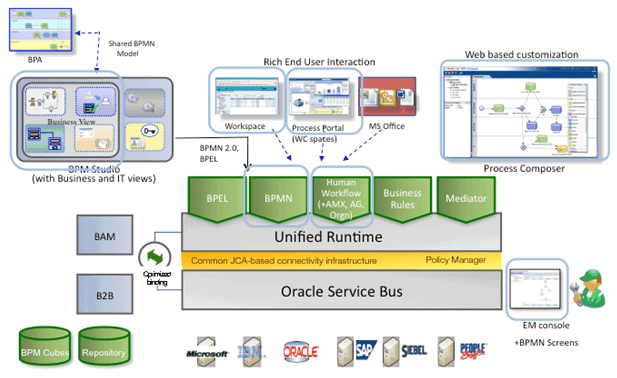Capacity Planning Playbook for Oracle Fusion Middleare. Labels: esb BPEL oracle fusion middleware capacity planning owsm bpel pm. No comments: Post a Comment. Newer Post Older Post Home. Subscribe to: Post Comments (Atom) Oracle Fusion Middleware In this blog I will post my findings for Oracle fusion Middleware, TIBCO and many more SOA/BPM/EPM. . Oracle Portal, Forms, Reports and Discoverer. Oracle Service Bus. Oracle SOA Suite and Oracle BPM Suite. Release Notes. FMW Repository Creation Utility User's Guide 4.
Capacity planning helps IT enterprises balance hardware costs with computing needs. The major objectives of effective capacity management are:
- Making efficient use of existing capacity.
- Minimizing wastage of computing resources.
To view capacity planning reports generated by Applications Manager: Cheap price 18toontrack ezdrummer ezx claustrophobic for mac.
- Click the Reports module tab to open the index page that lists all the reports generated by Applications Manager.
- Click on the Capacity Planning link in the list of reports at the left side of the page.
These reports render resources like CPU and Memory utilization for both Physical and Virtual Servers. Before proceeding, make sure that you have enabled reports for all the monitors. You can get reports over various customized time periods. The capacity planning reports can be exported in .pdf, excel, CSV and e-mail formats. The reports are classified into three types:
Undersized Monitors/Machines

These are servers that consistently use nearly all of their configured capacity. For a given amount of time, if the average CPU or Memory utilization of a server are very high, the resources allotted to the server is undersized. The server need to be right-sized so that workloads running within the virtual machine can get sufficient resource capacity.
Oversized Monitors/Machines
These are servers that consistently use less resources than their configured capacity. For a given amount of time, if the average CPU or Memory utilization of a server are very low, the resources allotted to the server is oversized. The server needs to be right-sizeddown to a lower capacity that is sufficient for the workloads running within the virtual machine.
Idle Monitors/Machines
With Applications Manager capacity planning reports you can also view individual resource utilization details of a particular monitor for a specific time interval configured by the user. These are monitors that show an insignificant level of capacity usage on one or more resources most of the time. For example, say the average CPU utilization is very low over most hours of day. This analysis is to identify servers that are not being used, for example, users are no longer running workloads.
Rightsizing Virtual Machines
Applications Manager analyzes oversized and undersized machines using CPU and memory utilization metrics. A utilization threshold is configured for a specific metric like CPU or Memory. If a machine uses resources capacity less than this threshold, the machine is oversized. The degree to which a virtual machine is oversized is calculated along with the the amount of time a machine spends in an overutilized state.
Similarly, if a machine uses resources capacity more than this threshold, the machine is undersized. The degree to which a virtual machine is undersized is calculated along with the the amount of time a machine spends in an underutilized state. You can view the reports for selected servers from the Select Server drop-down list. You can also select a particular Monitor group from the Select Monitor Group drop-down.
Click on the server type to generate reports for the specified time period and threshold limit. You can set the conditions to be satisfied for a server to be undersized, oversized or idle.
Click on one of the server types (undersized, oversized or idle servers). A new window is opened to display a capacity planning report with server details like:
- Monitor Name - Name of the Monitor
- Undersized/ oversized/ idle - The state of the server.
- CPU Utilization - Percentage of CPU Utilized
- Memory Utilization - Percentage of Memory Utilized
- User Notes - The user can add and save notes which will appear in the report.
The attribute column is RED or GREEN and the undersized column has values YES or NO respectively, depending upon the condition specified. By default the table shows all the monitors for the day. You can click on the Show Undersized/ Oversized/ Idle Servers Today button to show only the respective servers for the day. Click on the YES or NO under the Undersized/ Oversized/ Idle column in the capacity planning table to view a Utilization Summary and an Hourly Utilization Details Report. Click on any of the attributes under the CPU Utilization or Memory Utilization column to get an indepth history data for that particular attribute(Disk Utilization History Report, Hour of Day Report ,Day of Week Report, Statistical Report and Heat Chart). You can select required attributes from the drop down menu in the right-hand corner of the page.
Configure settings for diagnosis

Configure the following details for the server. To change values of attributes used in diagnosis,click on Change settings Used in Diagnosis button and update respective values:
- Servers are Undersized if Percentage of Time (The time for which CPU & Memory Utilization should be more or less than the configured value)
- Conditions used in diagnosis of Undersized Server (You can select any one or all of the conditions)
| Monitor Type | Attribute |
|---|---|
| Servers |
|
| VMWare ESX/ESXis |
|
| Hyper-V-Servers |
|
| Virtual Machines |
|
| XenServer |
|
My question is: Are there any white papers, best practices or Open World presentations that are more current than the 10g documentation and presentations I have found on searching that would cast the Oracle Fusion middleware more in a 'generic EAM context' than this 12 C product installation documentation I am looking at?